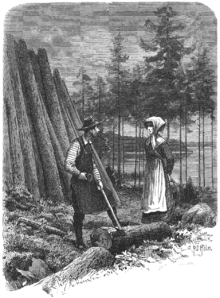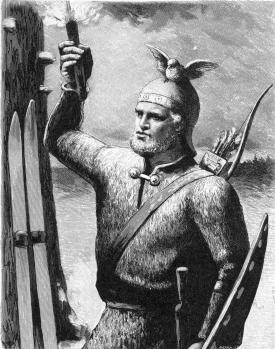 The Huldra is a seductive forest creature found in Scandinavian folklore. (Her name derives from a root meaning "covered" or "secret".) In Norwegian folklore, she is known as the skogsrå or skogsfru/skovfrue (meaning "Lady (read, counterpart of a Lord) of the forest"). She is known as Tallemaja (pine tree Mary) in Swedish folklore, and Ulda in Sámi folklore. Her name suggests that she is originally the same being as the völva Huld and the German Holda. A male hulder is called a huldu, or, in Norway, a huldrekarl.
The Huldra is a seductive forest creature found in Scandinavian folklore. (Her name derives from a root meaning "covered" or "secret".) In Norwegian folklore, she is known as the skogsrå or skogsfru/skovfrue (meaning "Lady (read, counterpart of a Lord) of the forest"). She is known as Tallemaja (pine tree Mary) in Swedish folklore, and Ulda in Sámi folklore. Her name suggests that she is originally the same being as the völva Huld and the German Holda. A male hulder is called a huldu, or, in Norway, a huldrekarl. Male huldes, called Huldrekarl, also appear in Norwegian folklore. This being is closely related to other underground dwellers, usually called tusser. Like the female counterpart, the huldrkarl is a shapeshifter who often lures girls under a fair countenance.
Features
The huldra is a stunningly beautiful, sometimes naked woman with long hair; though from behind she is hollow like an old tree trunk, and has an animal's tail. In Norway, she has a cow's tail, and in Sweden she may have that of a cow or a fox. Further in the north of Sweden, the tail can be entirely omitted in favor of her hollow or bark-covered back.In Norway, the huldra has often been described as a typical dairymaid, wearing the clothes of a regular farm girl, although somewhat more dazzling or prettier than most girls.
Folklore
The huldra is one of several rå (keeper, warden), including the aquatic Sjörå (or havsfru), later identified with a mermaid, and the bergsrå in caves and mines who made life tough for the poor miners.More information can be found in the collected Norwegian folktales of Peter Christen Asbjørnsen and Jørgen Moe.
Relations with humans
A boy in Tiveden went fishing, but he had no luck. Then he met a beautiful lady, and she was so stunning that he felt he had to catch his breath. But, then he realized who she was, because he could see a fox's tail sticking out below the skirt. As he knew that it was forbidden to comment on the tail to the lady of the forest, if it were not done in the most polite manner, he bowed deeply and said with his softest voice, "Milady, I see that your petticoat shows below your skirt". The lady thanked him gracefully and hid her tail under her skirt, telling the boy to fish on the other side of the lake. That day, the boy had great luck with his fishing and he caught a fish every time he threw out the line. This was the huldra's recognition of his politeness.In some traditions, the huldra lures men into the forest to have sexual intercourse with her, rewarding those who satisfy her and often killing those who do not. The Norwegian huldra is a lot less bloodthirsty and may simply kidnap a man or lure him into the underworld. She sometimes steals human infants and replaces them with her own ugly huldrebarn (changeling huldre children). In some cases, the intercourse resulted in a child, being presented to the unknowing father. In some cases, she forces him to marry her. Stories of such relationships were common in Norway a long time - an elderly man from Valdres claimed he had a child among the hulderpeople on Norwegian radio broadcasting. He was still alive around 1980.
Sometimes she marries a local farm boy, but when this happens, the glamour leaves her when the priest lays his hand on her, or when she enters the church. Some legends tell of husbands who subsequently treat her badly. Some fairy tales leave out this feature, and only relate how a marriage to a Christian man will cause her to lose her tail, and let the couple live happily ever after. However if she is treated badly, she will remind him that she is far from weak, often by straightening out a horseshoe with her bare hands, sometimes while it is still glowing hot from the forge.
If betrayed, the huldra can punish the man severely, as in one case from Sigdal, when she avenged her pride on a young braggart she had sworn to marry, on the promise that he would not tell anybody of her. The boy instead bragged about his bride for a year, and when they met again, she beat him around the ears with her cow's tail. He lost his hearing and his wits for the rest of his life.
Hunting
The hulder has long been associated with hunting; she might blow down the barrel of a huntsman's rifle, causing it never thereafter to miss a shot. Some men are not so lucky, or perhaps skilled, and escape her only after surrendering their sanity.A typical Huldra story
Once there was a married man, who was out looking for his cattle when he came upon a Huldra (or skogsrå). Unable to withstand the temptation, he went with her and made love to her becoming obsessed by her. He would return and make love to her every evening after that. Before long it began to be too much for him, draining him to the point where he collapsed. However, still he could not resist her. Eventually it got to be too much for him, the poor man became so exhausted that he could hardly walk. He didn't know what to do, so on one of his visits he asked the Huldra what he ought to do about a bull that he owned. The bull never did anything but mount the cows so that both the bull and cows were completely worn out and the cows had stopped giving milk.The Huldra advised him to gather some tibast (Daphne mezereum) and vandelrot (Valeriana officinalis). The man obtained some of these herbs and pinned it to himself before going to meet her that evening. As soon as she saw him she cried, "Tibast and vandelrot is sure, fie on me for telling the cure!" And with that she turned around, so that he saw her from behind breaking the spell, and then disappeared.
The man in this legend narrowly escapes an obscure doom. These creatures, even when treated well, are reported to have evil, disruptive intentions, as their very presence fills one with foreboding. Folkloric stories such as this one offers advice on how to avoid, conquer or escape from encounters with the Huldra or Skogsrå
Toponyms
A multitude of places in Scandinavia are named after the Hulders, often places that are by legend associated with the presence of the "hidden folk". Here are some examples showing the wide distribution of Hulder-related toponyms between the northern and southern reaches of Scandinavia, and the terms usage in different language groups' toponyms.Danish
- Huldremose (Huldra Bog) is a bog located on Djursland, Denmark famous for the discovery of the Huldremose Woman, a bog body from 55 BC.
Norwegian
- Hulderheim is located southeast on the island Karlsøya in Troms, Norway. The name means "Home of the Hulder".
- Hulderhusan is an area on the southwest of Norway's largest island Hinnøya, the name of which means "Houses of the Hulders".
Sámi
- Ulddaidvárri in Kvænangen, Troms (Norway) means "Mountain of the Hulders" in North Sámi.
- Ulddašvággi is a valley southwest of Alta in Finnmark, Norway. The name means "Hulder Valley" in North Sámi. The peak guarding the pass over from the valley to the mountains above has a similar name, Ruollačohkka, meaning "Troll Mountain" - and the large mountain presiding over the valley on its northern side is called Háldi, which is a term similar to the above mentioned Norwegian rå, that is a spirit or local deity which rules a specific area.





 Ullr
is a very old god of the northern lands, so old that by the time the
Iron Age Norse myths were written down, not much more was known about
him except that he was a god of archery, hunting, and the winter. His
name occurs so frequently as part of Scandinavian place-names that he
must have been a much more important deity at one time. He was shown
frequently with skates or skis on his feet, and because of this he has
been hailed as the modern God of Skiing. One story talks about him
"crossing water on a magic bone", alluding to crossing the frozen ice on
skates. He was also called God of the Shield, and the shield was
referred to as his "ship", which may be a reference to using a shield or
shield-shaped board as a sled … or to the ice of winter enveloping the
world like a shield.
Ullr
is a very old god of the northern lands, so old that by the time the
Iron Age Norse myths were written down, not much more was known about
him except that he was a god of archery, hunting, and the winter. His
name occurs so frequently as part of Scandinavian place-names that he
must have been a much more important deity at one time. He was shown
frequently with skates or skis on his feet, and because of this he has
been hailed as the modern God of Skiing. One story talks about him
"crossing water on a magic bone", alluding to crossing the frozen ice on
skates. He was also called God of the Shield, and the shield was
referred to as his "ship", which may be a reference to using a shield or
shield-shaped board as a sled … or to the ice of winter enveloping the
world like a shield.
 Ullr
was said to be the son of Sif and the stepson of Thor. Some claim that
he was the son of Egill/Aurvandil, the great archer who was Thor's
hunting companion and the father of Svipdag as well. Some see him as
Aesir because of his mother and stepfather; some as Vanir because of his
food-procuring hunter's nature. He lived in Ydalir, the Yew-grove,
referring to the fact that yew wood was the favorite for making bows
even thousands of years ago. In Saxo Grammaticus's works, where the Gods
are recast as human heroes, Odin is temporarily exiled for rape and
Ullr is chosen to lead in his place until Odin's return, which is an
echo of his former importance to the people of the North.
Ullr
was said to be the son of Sif and the stepson of Thor. Some claim that
he was the son of Egill/Aurvandil, the great archer who was Thor's
hunting companion and the father of Svipdag as well. Some see him as
Aesir because of his mother and stepfather; some as Vanir because of his
food-procuring hunter's nature. He lived in Ydalir, the Yew-grove,
referring to the fact that yew wood was the favorite for making bows
even thousands of years ago. In Saxo Grammaticus's works, where the Gods
are recast as human heroes, Odin is temporarily exiled for rape and
Ullr is chosen to lead in his place until Odin's return, which is an
echo of his former importance to the people of the North.




 And you take only what is needed,
And you take only what is needed,